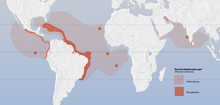Red-billed tropical bird
| Red-billed tropical bird | ||||||||||
|---|---|---|---|---|---|---|---|---|---|---|

Red-billed tropical bird ( Phaethon aethereus ) |
||||||||||
| Systematics | ||||||||||
|
||||||||||
| Scientific name | ||||||||||
| Phaethon aethereus | ||||||||||
| Linnaeus , 1758 |
The red-billed tropical bird ( Phaethon aethereus ) is a bird from the order of the tropical birds . Like all tropical bird species, it is characterized by extremely elongated middle tail feathers. Its swimming ability is quite poor, but its flying abilities are excellent and the birds can often be found hundreds of kilometers from land in the open sea.
The red-billed tropical bird is common in the tropical Atlantic, Eastern Pacific and Indian Oceans.
description
The red-billed tropical bird reaches a length of 61 cm, including the tail pennants 96 cm. The wingspan is up to 112 cm. There is no sexual dimorphism. The plumage of adult birds is predominantly white. A black band runs over the eye and, widening slightly, across the neck. The strong, slightly downward curved bill is coral red. The top shows a black stripe that extends to the rump and shoulder plumage. The outer hand covers and the inner arm wings are black, the underside of the wings white. As with all tropical bird species, the central control feathers are extremely elongated. In the red-billed tropical bird, they are white except for a black central stripe. The tail consists of 14 control feathers.
Young birds lack the elongated tail feathers or are at least greatly shortened. The upper side has strong black stripes and extends to the back of the head, the eye stripe is faded and merges into the stripes. The beak is yellow.
distribution
The red-billed tropical bird can be found in large parts of the oceans of the tropical and subtropical regions. It occurs in the Indian Ocean, the Atlantic and the Eastern Pacific. It only comes ashore during the breeding season and breeds in the Cape Verde Islands , Ascension , St. Helena , Fernando de Noronha , Galapagos , the islands off western Mexico and South America, in the Gulf of Aden and the Persian Gulf .
Subspecies
- P. a. aethereus - Linnaeus, 1758
- P. a. indicus - Hume, 1876
- P. a. mesonauta - JL Peters, 1930
Duration
Due to the large distribution area, the species is listed in the IUCN Red List as "not endangered". It is the rarest of the three tropical bird species, its world population is estimated at around 10,000 breeding pairs. Most breed on the Central American coasts. There are larger populations in the Galapagos Islands and the Caribbean. This species is very rare in the West Palearctic. Only between 100 and 125 breeding pairs breed on the Cape Verde Islands. There are also individual breeding records for the Azores. A breeding colony of at least eight pairs was confirmed for the Canary Islands in 2016.
supporting documents
literature
- GS Tuck, H. Heinzel: The sea birds of the world , Paul Parey publishing house, Hamburg / Berlin 1980, ISBN 3-490-07818-7
Web links
- Phaethon aethereus in the endangered Red List species the IUCN 2008. Posted by: BirdLife International, 2009. Retrieved on February 6, 2011th
- Videos, photos and sound recordings about Phaethon aethereus in the Internet Bird Collection
Single receipts
- ↑ N. Redman, T. Stevenson, J. Fanshawe: Birds of the Horn of Africa: Ethiopia, Eritrea, Djibouti, Somalia, and Socotra - Revised and Expanded Edition . Princeton University Press , 2016, ISBN 978-0-691-17289-7 , pp. 42 (English, full text in the Google book search).
- ↑ http://www.rarebirdalert.co.uk First colony of Red-billed Tropicbirds found on the Canary Islands, August 12, 2016


